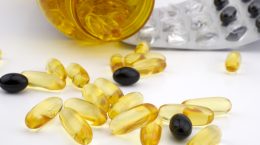Published on March 1, 2024
WEEKEND FLASH SALE: Save 15% on Any Test Kit Combination that Includes Your Omega-3 Index with Code “Omega3Day24”!
Key Points
- 80% of people worldwide are not getting enough EPA and DHA omega-3s (and in the US it’s higher than 95%)
- GrassrootsHealth published a paper that assessed the EPA+DHA intake requirement to achieve an Omega-3 Index of 8% or higher; ~1,300 mg/day of EPA+DHA was needed for 50% of the population to achieve an Omega-3 Index of 8%, and approximately 1,900 mg/day of EPA+DHA was needed for 90% of the population to achieve an Omega-3 Index of 8%
- the range of response with 1000 mg of EPA+DHA per day was 5.7% to 10.2%, therefore, we recommend that individuals measure their Omega-3 Index and determine a personalized dose
March 3rd is Global Omega-3 Day, initiated by the Global Organization for EPA and DHA Omega-3s (GOED); it is a day to focus on the importance of getting enough omega-3 fatty acids EPA (eicosapentaenoic acid) and DHA (docosahexaenoic acid) for our health. Higher levels of EPA and DHA have been associated with many positive health outcomes, including improved cognitive function and cardiovascular health, lower risk of dementia, lower risk of cancer, longer life, and a reduced relative risk for death from any cause. They are beneficial for normal vision, anti-aging, skin health, maternal health, immune system, brain health, heart health, normal liver function, joints and muscles, and so much more!
New research from this year even found that
- high dose DHA+EPA was best at decreasing frequency and severity of migraines, outperforming migraine medications (according to a network meta-analysis analyzed data from 40 randomized controlled trials (RCTs)) Read More
- those with the highest levels of DHA, EPA, or both had the lowest risk of total and ischemic stroke (according to data from 29 cohorts in 15 different countries) Read More
- middle-aged and older adults with higher DHA levels were 8% to 20% less likely to have age-related hearing issues than those with lower DHA levels (according to data from over 115,000 participants) Read More
- higher levels of omega-3 fatty acids — including DHA — were associated with better lung function (according to data from over 500,000 participants) Read More
Unfortunately, most individuals around the globe are not getting enough of these omega-3s to experience their health benefits.
Check Your Levels Today – Save 15% with Code OMEGA3DAY24 This Weekend Only!
Why do Omega-3s Need a Special Day?
To Share these Key Messages:
- 80% of people worldwide are not getting enough EPA and DHA omega-3s (and in the US it’s higher than 95%).
- When it comes to omega-3s, EPA and DHA are most important, not just for your heart or during pregnancy, but throughout your entire life.
- The best food source of EPA+DHA omega-3s are fatty/oily fish. You can also get these nutrients from an omega-3 supplement.
- Aim for at least 500mg EPA+DHA per day. Get this from eating fatty/oily fish, eating foods fortified with EPA/DHA, and by taking an omega-3 supplement.
- Pregnant and lactating women should get at least 700 mg per day of EPA+DHA, with at least 300 mg of that as DHA.
- There is no concern about the safety of EPA and DHA omega-3s. Both the US Food and Drug Administration (FDA) and the European Food Safety Authority (EFSA) recognize that long-term intake of 5g/day of EPA+DHA is safe.
Why is it Important to Focus on Your Omega-3 Index vs Intake?
The Omega-3 Index is a blood test that measures the amount of EPA and DHA in red blood cell (RBC) membranes and is expressed as a percent of total RBC fatty acids. It is a long-term and stable marker of omega-3 status, and it reflects tissue levels of EPA+DHA.
An Omega-3 Index of over 8% is associated with the lowest risk of death from heart disease and below 4% with the highest.
While individual levels of omega-3s vary across the globe, most countries and regions have levels that are considered low to very low.
 GrassrootsHealth has been providing at-home testing for omega-3 status along with education on levels that are beneficial to health, and how to track and achieve those levels through diet and supplementation. In November of 2019, using the data gathered, we published a paper that assessed the EPA+DHA intake requirement to achieve an Omega-3 Index of 8% or higher. This analysis found that among the 265 participants who reported no fatty fish intake (to ensure no major sources of EPA+DHA input beyond supplements), ~1,300 mg/day of EPA+DHA was needed for 50% of the population to achieve an Omega-3 Index of 8%. Approximately 1,900 mg/day of EPA+DHA was needed for 90% of the population to achieve an Omega-3 Index of 8%.
GrassrootsHealth has been providing at-home testing for omega-3 status along with education on levels that are beneficial to health, and how to track and achieve those levels through diet and supplementation. In November of 2019, using the data gathered, we published a paper that assessed the EPA+DHA intake requirement to achieve an Omega-3 Index of 8% or higher. This analysis found that among the 265 participants who reported no fatty fish intake (to ensure no major sources of EPA+DHA input beyond supplements), ~1,300 mg/day of EPA+DHA was needed for 50% of the population to achieve an Omega-3 Index of 8%. Approximately 1,900 mg/day of EPA+DHA was needed for 90% of the population to achieve an Omega-3 Index of 8%.
We ran this analysis again in February of 2020, with almost twice as many participants, and found the EXACT SAME results: ~1,300 mg/day of EPA+DHA was needed for 50% of the population and ~1,900 mg/day was needed for 90% of the population to achieve and Omega-3 Index of 8%.
It is important to point out that, similar to the large variability seen with vitamin D dose response to intake, these intake amounts are averages and there is a large amount of variability in the omega-3 status for different people with the same intake amount. For example, our initial analysis showed that the range of response with 1000 mg of EPA+DHA per day was 5.7% to 10.2%. Therefore, we recommend that individuals measure their Omega-3 Index and determine a personalized dose.
What Else Should You Know About Omega-3s and Your Omega-3 Status?
Check out our top omega-3 blogs below to learn more!
Research is now showing evidence that both DHA and EPA have unique benefits to our health
Could you be taking a fish oil supplement that does not provide nearly enough omega-3s EPA and DHA to benefit your health?
Is your Omega-3 Index not increasing with increased doses of fish oils? The type of fish oil supplement you are taking may be the culprit!
Symptoms of RA and other inflammatory diseases improved by decreasing pro-inflammatory fatty acids and increasing anti-inflammatory fatty acids through diet and supplementation
The top 5 scientifically proven benefits of omega-3 fatty acids, and how to make sure you are getting enough
New study finds a significant correlation between B vitamins and maintaining cognitive health, but only with higher levels of omega-3 fatty acid DHA in the blood
Taking B Vitamins for Cognitive Health? You May Not Get the Effect You Need without Enough Omega-3s!
While the Omega-3 Index is often considered the most important measure for omega-3 status, it is also useful to know your status of other omega fatty acids, such as with the AA:EPA ratio and the Omega-6:Omega-3 ratio
As many as 50% or more of the omega-3 fish oil supplements on the market are oxidized; why choosing high quality fish oil supplements is essential and how to find them
Association between Omega-3 Index and neutrophil-lymphocyte ratio (NLR) demonstrates link between immune system balance and EPA+DHA status
Study reveals effects of 6 weeks of omega-3 supplementation on the composition and function of the gut microbiome
Measure Your Omega-3s with Vitamin D and Other Important Health Markers
 Having and maintaining healthy omega-3 and vitamin D levels can help improve your health now and for your future. Choose which additional nutrients to measure, such as your essential minerals including magnesium and zinc, by creating your custom home test kit today. Take steps to improve the status of each of these measurements to benefit your overall health. With measurement you can then determine how much is needed and steps to achieve your goals. You can also track your own intakes, symptoms and results to see what works best for YOU.
Having and maintaining healthy omega-3 and vitamin D levels can help improve your health now and for your future. Choose which additional nutrients to measure, such as your essential minerals including magnesium and zinc, by creating your custom home test kit today. Take steps to improve the status of each of these measurements to benefit your overall health. With measurement you can then determine how much is needed and steps to achieve your goals. You can also track your own intakes, symptoms and results to see what works best for YOU.
Enroll in D*action and Test Your Levels Today!







